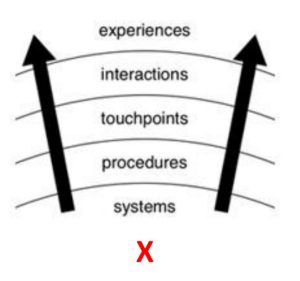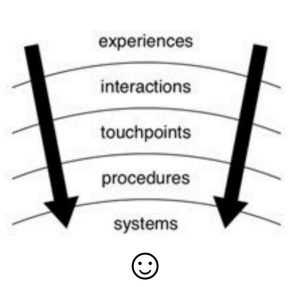I recently completed a training to become a certified UX-PM trainer. While I’ve worked in the UX field for the last 7 years, going through this training was a nice, compact reminder of how to integrate UX into the overall product design experience. It was a great opportunity to think big picture, to think about how to maximize the customer’s experience, and to think about the various touchpoints and individuals that contribute to this effort. As the trainer put the following image on the screen, something seemed to click.
 |
 |
While many companies have existing systems they have to work within, consider what would happen if that model were turned upside down. Instead of thinking about how to mold a service or product experience within the constraints of existing systems, what if the systems were designed to make for a seamless experience for the customer?
You may be thinking to yourself that you or your business do consider the customer/user, that you have friendly staff, and that you strive to make each interaction with your customers a positive one. You may even have done work to design and test interfaces so that your customers are able to work within and use your systems effectively. I challenge you to think big picture, to think about whether there are parts of your service that could be reimagined, starting with the experience you want your customer to have and working “backward” from there.
Consequences of not designing for customers
I had an experience that came to mind as soon as I saw those diagrams. It was a perfect illustration of the systems out approach. Allow me to set the scene:
I was scheduled for my annual car maintenance. A few weeks before my scheduled appointment, I started receiving alerts on my dash that 1) I was due for an oil change and 2) that my keyfob battery needed to be replaced. I had a road trip planned and the battery warning was especially disconcerting to me, as I didn’t want to be locked out of the car three states from home. As a result, I moved up the appointment a month to get it taken care of. I even brought the batteries with me to the appointment because I wasn’t sure if they would be provided.
Here’s where the fun started.
To spare you some of the detail, I have broken down my experience into the four main issues that I encountered below, alongside some takeaways.
1. Information provided to the customer was incomplete and unclear
In my first meaningful interaction with the mechanic/service coordinator (which took place after they had looked at the car), he told me that beyond the service check, I would need to replace an “impacted” tire and adjust the car’s automatic alignment, all for a hefty $500+ price tag. Despite my attempts to get additional information about the necessity of making these repairs immediately, I couldn’t get an answer beyond “all the repairs are recommended.”
It would have been much more helpful to tell me which repairs were required (as in, which could have a safety-impact), which might be superficial, and what consequences I would face if I didn’t address them. More information would have made me feel as though I could make a properly informed decision, especially in light of the high price tag.
I authorized the tire replacement and later received an invoice. Because of the way the charges were listed on the invoice, I initially thought there was an accidental overcharge, and ended up calling to get more information about the additional item on the invoice (it ended up being a tax).
Transparency up front and during the appointment and clear itemization of each invoice charge could have resolved my questions and left me not questioning the transaction.
My questions and concerns could have been preempted, or at the very least acknowledged, by:
- Use of layman’s terms in place of technical language
- Assistance in assessing criticality of issues
- Acknowledgment of budgetary constraints
- Clear presentation of charges and costs in the invoice
2. The main repair center customer service line had no access to information
When I drove my car the next time, I saw a warning in the dash telling me that my keyfob battery was low. This was particularly upsetting because this was the thing I had asked explicitly to be fixed.
I called the service center to find out what the problem was. I would have expected them to have access to a record of my recent appointment and a list of the repairs that were done but was told instead that someone would reach out to me later that day with an answer. I never got a return call.
The customer should not be expected to understand and juggle different parts of an organization that don’t communicate with each other. If it’s necessary for there to be multiple systems, they must appear as one to customers, so that from the customers’ perspective, there is one cohesive organization and experience.
3. There was no way for me to escalate my complaint
After waiting for the call that never came, I received a customer satisfaction survey. Me being a UXer, I was curious whether filling it out would escalate the issue, so I completed the survey. I was honest about my experience.
I subsequently received a follow-up text from the service coordinator I had been communicating with during my appointment (I received text updates during the appointment, which was nice and made a positive impression at the time). It struck me as odd to receive a text follow up to my satisfaction survey from the individual with whom I was dissatisfied. Also, I thought the text channel was available for appointment updates only. This could have been a nice feature of this service model if the purpose of the text channel was made clear up front (back to point #1), but equally important, this didn’t really feel like my complaint was being escalated at all. I had just complained about the interaction with this guy in a survey, now here he was texting me to resolve the issue. Where I expected a quick reply via text, it took me six days and four separate messages to get the mechanic to tell me that the batteries had been changed in the key fobs.
When responding to a complaint, consider who the customer would want to communicate with and give the sense that the complaint was addressed and was being listened to. It’s unlikely that a customer will feel appeased if they had a dissatisfactory interaction with an employee, complain, then get rerouted to that person.
4. Scheduling and reminder calls were being handled by a separate call center, that was not being updated by the service center staff
Last but not least, while trying to get an answer to the battery question, I began receiving reminder calls for my original appointment that I had cancelled weeks before. I even went so far as to call their general number and remind them that the appointment had been cancelled. I then received a message after the appointment was supposed to have taken place that told me I had missed my appointment.
Beyond confirming for me that the service number was a black hole, there was some issue with their internal communications where one side clearly didn’t update another and I was the one somehow coming out feeling as though I had dropped the ball somewhere.
Back to point #2. The customer should not be able to tell that there are multiple entities, much less be able to see communication rifts between the different entities. Most importantly, the customer should not be made to feel responsible for errors that are occurring on the company’s side.
Improving the experience with the customer in mind
This blog is not intended to be a rant about my negative experience, but an acknowledgement that creating a positive customer experience often requires attending to the multiple touchpoints at which the customer engages with your product or service. Systems that seem adequate (the text communication channel could have been great) can make for a negative overall experience when expectations are not set appropriately.
There will always be constraints to consider when designing experiences for customers or users. There will be things that can’t be changed. Designing the ideal customer experience is completely possible within those constraints. It might just mean sitting down with, listening to, and empathizing with your customers, to understand what they need from you. Once you design that experience and build that trust with your customers, they will stick with you.
